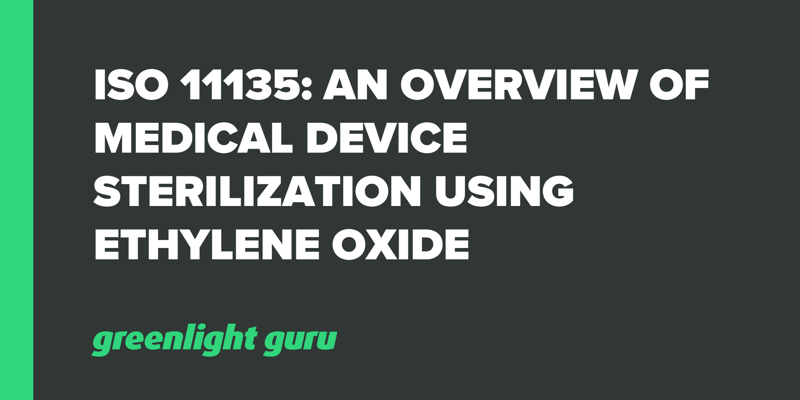ISO 11135: An Overview of Medical Device Sterilization Using Ethylene Oxide

Once a medical device has been designed, developed, and manufactured to specifications, it may feel as though a major bridge has been crossed. Soon, the device will be in the hands of end users, helping patients around the world.
For many medical devices, however, there’s one more important step in the manufacturing process: sterilization.
Unsterilized or poorly sterilized devices present a serious risk to the health of its users. Fortunately, there are a number of ways to sterilize medical devices. While the decision to use one method over another is based on a number of factors, one of the most popular methods of sterilization is the use of ethylene oxide (EO) gas.
Ethylene oxide is an excellent sterilization tool, but the safe and effective use of EO requires close attention to detail. Because there is so much on the line, the International Organization of Standardization has created a standard—ISO 11135—to guide manufacturers in the ethylene oxide sterilization process and its validation.
Let’s review those ISO 1135 guidelines in detail so you can understand how to apply them to your medical device.
WANT TO BECOME A MEDICAL DEVICE INSIDER? Get VIP access to the best medical device content, checklists/templates & events delivered to your inbox every week by subscribing to our newsletter now!
What is ISO 11135?
ISO 11135 is the international standard that details the development and validation of a process for sterilizing medical devices using ethylene oxide.
Ethylene oxide has been used for sterilization since the 1940s. One of the primary reasons for EO’s popularity is its ability to penetrate plastic packaging and sterilize the devices inside. Of course, it’s impossible to verify that each device has been appropriately sterilized without opening the package and rendering the product unsterile once again.
That’s why ISO 11135 exists. It provides guidance on how to validate the sterilization process. Once the process as a whole has been validated, the medical device manufacturer, regulatory bodies, and end users can be confident that the final product is sterile.
What is the sterilization process outlined in ISO 11135:2014?
Ethylene oxide has an amazing ability to penetrate plastic barriers and kill microorganisms—known as the “bioburden”—that may be present within packaging, tubing, or other nooks and crannies within a device.
However, EO is also highly flammable and carcinogenic, meaning there are a number of precautions and measures that must be taken to ensure that it is used safely. For instance, due to EO’s flammable nature, the sterilization chamber is maintained at a sub-atmospheric pressure, generally below six pounds per square inch absolute (psia).
ISO 11135 breaks down the ethylene oxide sterilization process into three stages:
-
Preconditioning
-
Sterilization
-
Aeration
Preconditioning
Before sterilization, the chamber in which the products will be sterilized is conditioned for temperature and humidity. The purpose is twofold. First, it conditions the packaging material to allow the EO to penetrate more easily. Second, the humidity conditions the cellular walls of any microorganisms to be less resistant to the EO gas.
Sterilization
Because ethylene oxide is flammable at around 10% oxygen concentration, the air in the chamber must first be removed from the chamber using a vacuum. Once this is done, the EO is injected into the chamber and the sterilization process begins.
Aeration
The third and final stage of the sterilization process is the removal of the EO from the chamber. This is usually done by flushing the chamber with steam or an inert gas, like nitrogen. Afterward, the product will be placed in an aeration chamber that circulates hot air and helps eliminate residual EO that might otherwise be absorbed into the product.
Using ISO 11135 to guide validation of EO sterilization
Ethylene oxide is an excellent tool for sterilizing medical devices, but you’ll still need empirical evidence that your sterilization process destroys any bioburden present on your products. The simplest way to do this is by using ISO 11135 as a guide for your process validation.
Process validation consists of three stages, IQ, OQ, and PQ. Installation qualification (IQ) and operational qualification (OQ) consist of ensuring that the equipment required to carry out the sterilization process is installed and operating correctly.
Performance qualification (PQ) is what proves that the process is able to consistently sterilize your products under real-world conditions. PQ consists of two stages, microbiological performance qualification and physical performance qualification.
Greenlight Guru has established an automated system for the validation process with its medical device-specific software that comes validated out of the box, providing medical device companies with 21 CFR Part 11–compliant IQ protocol, completed OQ, and PQ reports.
Microbiological Performance Qualification (MPQ)
During MPQ, the manufacturer’s job is to determine the minimum process parameters to ensure that the product’s bioburden is destroyed. Generally, a Biological Indicator (BI) is placed in the product to simulate contamination. The BI is usually a strip covered in at least one million bacteria with a resistance to EO.
The most popular method of MPQ is known as the “overkill” method. It consists of running a half-cycle (half the standard time the product is in the sterilization chamber) and then demonstrating that the half-cycle is sufficient to destroy the BI.
If three consecutive half-cycles destroy the BI, then it may be assumed that the full cycle the manufacturer is planning on running will be “overkill.”
Physical Performance Qualification (PPQ)
PPQ consists of at least three full sterilization cycles, and must demonstrate that the process is reproducible and that the product still performs as intended after sterilization.
WANT TO BECOME A MEDICAL DEVICE INSIDER? Get VIP access to the best medical device content, checklists/templates & events delivered to your inbox every week by subscribing to our newsletter now!
Simplify Compliance with ISO 11135 by validating your device sterilization process in Greenlight Guru
Process validation is essential to ensuring your medical device is sterilized and safe for patients. Performing process validation is only half the battle, however. You also need to document your conformity with standards like ISO 11135 and make sure that documentation is readily available.
With Greenlight Guru’s QMS software, you can use Document Management to ensure alignment with suppliers, contract manufacturers, consultants, and auditors by leveraging the ability to share key documents like SOPs, WIs, or product-specific records with external partners.
Access all of your most important documents in one secure, easily navigable system. Get your free demo of Greenlight Guru today →
Looking for a design control solution to help you bring safer medical devices to market faster with less risk? Click here to take a quick tour of Greenlight Guru's Medical Device QMS software
Laura Court is a Medical Device Guru and Mechanical Engineer who loves learning about new technology and sharing her experiences with others. She has experience in New Product Development and Manufacturing with both small and large companies. Having managed products through their full product lifecycle into post...









